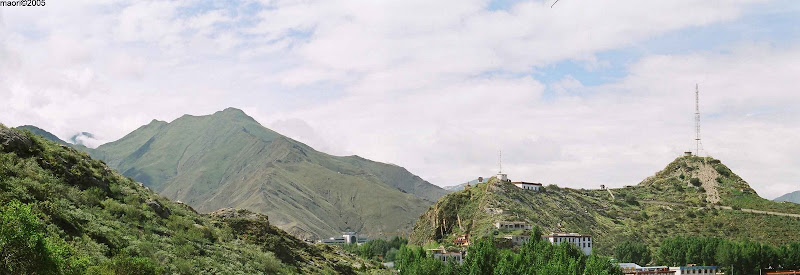The Potala is perhaps the most important and well known symbol of Tibet. It is a 13-storey castle over 117m high blend into the hill ("red hill", well using the word hill may be an understatement here since the red hill is about 3,700m above sea-level, highest than most mountains in the world) it is built on. The Potala contains over a thousand rooms, and is thought to house 10,000 shrines and 200,000 statues. Original construction dates back to the 7th century, the White Palace was completed in 1653 and the Red Palace in 1694.
Entrance to the Palace is by the west gate. Then one walks up the ramp around the back of the Palace to the building entrance at the eastern side. The entrance leads to an open courtyard, which leads to the White Palace, which houses the former living quarters of the Dalai Lama.
But entrance to the living quarters of the Dalai Lama (which is open to the public) is actually through another rooftop courtyard, reached after climbing a staircase in the White Palace building. The other side of the courtyard is the entrance to the Red Palace.
After entering the Red Palace, one goes downward through four levels to the bowels of the building to exit by the same car ramp. The upper levels of the Red Palace enclose an open skylight space, with chapels arrayed in a gallery-like rectangle around that space. Interspersed through the many chapels and shrines of the Red Palace are the eight gold-plated stupas, each containing the salt-dried body of a past Dalai Lama.
Photography is not allowed inside the Palace, and it is said that this is enforced by the caretakers as well as numerous video surveillance cameras in the building. (Perhaps with camera mobile phones nowadays it is possible to sneak some pictures.) The only photographs that can be taken in the Palace are at the rooftop courtyards. Anyway you can't get good vantage points to take photos of the Potala exterior in the Palace grounds (they are at the Potala Square, Chakpori Hill, Luklang Park and rooftop of Jokhang). But the treasures inside the Potala are truly stunning, with stupas of the Dalai Lama ranging over several storeys,fine murals, gilden statue, three-dimensional mandela, exquisite craftworks, a vast assemby hall illuminated by skylight.
View Larger Map1.A row of prayer wheel at west gate of Potala
2. Up the car ramp to Potala
3. Looking south from the car ramp, on the right is Chakpori Hill
4. One enters the palace building on the eastern side which leads to an open courtyard. In the background is the White Palace.
5. From the first courtyard, one climbs a flight of stairs to another rooftop courtyard. On one side of the courtyard is the entrance to the living quarters of the Dalai Lama at the White Palace, another side of the courtyard is the entrance to the Red Palace.
6. Looking at the Red Palace from the rooftop area
7. A golden roof. The Tibetans use the golden roof to mark important locations in the Potala, such as chapels and stupas of past Dalai Lamas.
8. Looking at Lhasa city from the roof
9 to 11. Ornaments
12. A window
13. Agar dance. Some workers repairing the roof
14. This is the central open skylight space of the Red Palace
15. View of north Lhasa while going down from the exit to the ramp.
16. This is a view of the Sera Monastery from Potala, taken with a telephoto lens.






